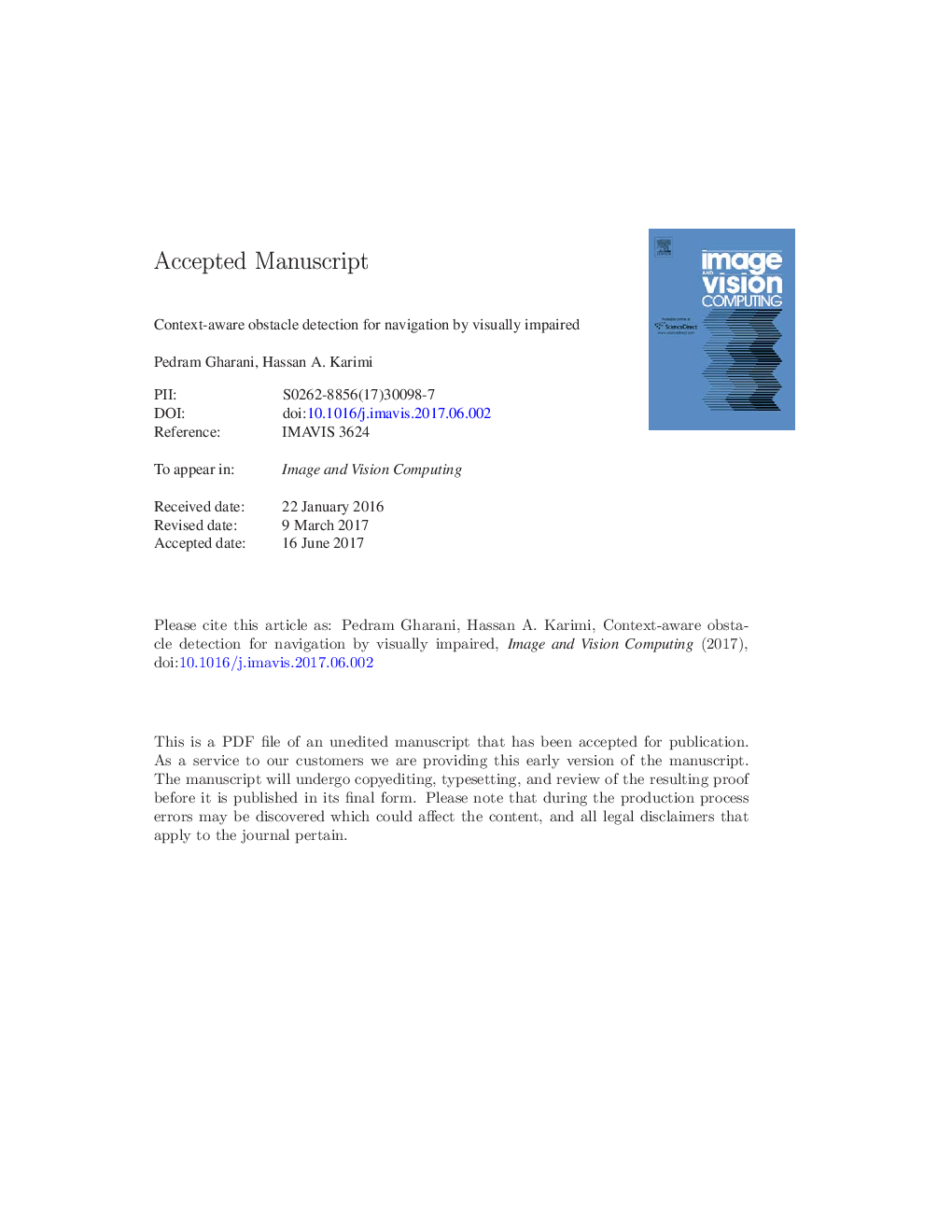| کد مقاله | کد نشریه | سال انتشار | مقاله انگلیسی | نسخه تمام متن |
|---|---|---|---|---|
| 4968979 | 1449842 | 2017 | 24 صفحه PDF | دانلود رایگان |
عنوان انگلیسی مقاله ISI
Context-aware obstacle detection for navigation by visually impaired
ترجمه فارسی عنوان
شناسایی مانع از آگاهی برای ناوبری با اختلال دید
دانلود مقاله + سفارش ترجمه
دانلود مقاله ISI انگلیسی
رایگان برای ایرانیان
کلمات کلیدی
تشخیص موانع، ناوبری داخل ساختمان، ناوبری بصری، دارای اختلال بینایی،
ترجمه چکیده
این مقاله رویکرد تشخیص موانع بصری مبتنی بر گوشی هوشمند مبتنی بر فناوری را برای کمک به افراد مبتلا به اختلال دید در محیط محیط داخلی ارائه می دهد. این روش بر اساس پردازش دو فریم متوالی (تصاویر)، محاسبه جریان نوری و ردیابی نقاط خاصی برای شناسایی موانع است. نرخ فریم فیلم جریان با استفاده از تکنیک تلفیقی داده متمرکز برای سنسورهای گوشی های هوشمند تعیین می شود. از طریق یک الگوریتم کارآمد و جدید، یک مجموعه داده نقطه در هر فریم متوالی طراحی و ارزیابی می شود تا بررسی کند که آیا نقاط مربوط به یک مانع است یا خیر. علاوه بر تعیین نقاط بر اساس بافت در هر فریم، الگوریتم ما همچنین عنوان حرکت کاربر را برای یافتن مناطق بحرانی در صفحه تصویر بررسی می کند. ما الگوریتم را از طریق آزمایشات با مقایسه آن با دو الگوریتم قابل مقایسه تایید کردیم. این آزمایش ها در محیط های مختلف محیط انجام شد و نتایج بر اساس دقت، فراخوان، دقت و اندازه گیری فاکتور مقایسه و تحلیل شد. نتایج نشان می دهد که در مقایسه با دو الگوریتم دیگر برای این فرآیند، الگوریتم ما دقیق تر است. ما همچنین پارامتر زمان تماس را برای خوشه بندی نقاط در نظر گرفتیم و با استفاده از این پارامتر بهبود عملکرد خوشه بندی را ارائه کردیم.
موضوعات مرتبط
مهندسی و علوم پایه
مهندسی کامپیوتر
چشم انداز کامپیوتر و تشخیص الگو
چکیده انگلیسی
This paper presents a context-aware smartphone-based based visual obstacle detection approach to aid visually impaired people in navigating indoor environments. The approach is based on processing two consecutive frames (images), computing optical flow, and tracking certain points to detect obstacles. The frame rate of the video stream is determined using a context-aware data fusion technique for the sensors on smartphones. Through an efficient and novel algorithm, a point dataset on each consecutive frames is designed and evaluated to check whether the points belong to an obstacle. In addition to determining the points based on the texture in each frame, our algorithm also considers the heading of user movement to find critical areas on the image plane. We validated the algorithm through experiments by comparing it against two comparable algorithms. The experiments were conducted in different indoor settings and the results based on precision, recall, accuracy, and f-measure were compared and analyzed. The results show that, in comparison to the other two widely used algorithms for this process, our algorithm is more precise. We also considered time-to-contact parameter for clustering the points and presented the improvement of the performance of clustering by using this parameter.
ناشر
Database: Elsevier - ScienceDirect (ساینس دایرکت)
Journal: Image and Vision Computing - Volume 64, August 2017, Pages 103-115
Journal: Image and Vision Computing - Volume 64, August 2017, Pages 103-115
نویسندگان
Pedram Gharani, Hassan A. Karimi,
